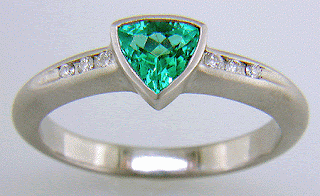What is With All the Birthstone Confusion?
Your associated birthstone depends on where you look, (and what you like!)
Many believe that the Breastplate of Aaron is the basis for the origin of birthstones (also known as natal stones). The instructions for fabricating the Breastplate are in Exodus 28, 15-30: and call for the twelve stones of the Twelve Tribes of Israel to be set in four rows. These gemstones corresponded to the zodiac signs of the time.
Our present calendar month system was not known at the time of Exodus and today birthstones have come to be more commonly associated with the calendar month of birth than with the zodiac sign. Most people refer to these "Modern Birthstone Charts". However, many choose between charts including the Traditional, Ayurvedic and Mystical Birthstone charts; Zodiac sign birthstones and Bible Stones.
As an October baby, I had three choices of birthstones and for years, I chose to adopt the traditional Opal over Rose Zircon. That was before I learned more about my third choice, Tourmaline! So now, in case you are shopping, (Frank) ...
 | ||
| Yummy Tourmaline |
The gemstone Tourmaline is one of two official birthstones for October as adopted by the American National Association of Jewelers in 1912. The other being Opal. Thankfully, they did not recognize Rose Zircon.
 |
| Not Too Shabby of a Choice: Opal |
Did you know?
There are 14 officially recognized varieties of tourmaline. And, the name "tourmaline" comes from the Sinhalese (Sri Lanka) word tura mali which translates as the stone of mixed colors.
Tourmaline can have different colors from black, green, pink, yellow, light blue, dark blue, and colorless. Bi-colored and multicolored tourmaline may be green at one end and pink at the other.
Ancient legend says that tourmaline is found in all colors because it traveled along a rainbow. In doing so, it assumed all the colors of the rainbow. And that is why it is still referred to as the 'gemstone of the rainbow' today. Tourmaline has a hardness of 7-7.5 on the Moh’s hardness scale, (about the same hardness as sand and dust), thus tourmaline is not recommended for use in rings and bracelets for everyday wear.
 |
| Tourmaline Crystal |
The most famous type of multiple coloration is the watermelon tourmaline; watermelon tourmaline is green on the outside and pink on the inside.
A tourmaline of an intense red is known as a 'rubellite', but only if it continues to display the same fine ruby red in artificial light as it did in daylight. If the color changes when the light source does, the stone is called a pink or shocking pink tourmaline.
 |
| Shocking Pink Oro Tourmaline or Pink Rubelite |
In the language of gemologists, blue tourmaline is known as 'indicolite', yellowish-brown to dark brown, as 'dravite' and black ones as 'schorl'. A particularly popular variety is the green tourmaline, known as a 'verdelite' in the trade. However, if its fine emerald-like green is caused by tiny traces of chrome, it is referred to as a 'chrome tourmaline'. The most expensive tourmalines are the blue indicolite, green verdelite and pink rubellite.
 |
| Verdelite |
Some stones are dichroic meaning they appear to change color when viewed from different angles. Some change their color when the light changes from daylight to artificial light, and some show the light effect of a cat's eye.
The absolute highlight among the tourmalines is the 'Paraiba tourmaline', a gemstone of an intense blue to blue-green which was not discovered until 1987 in a mine in the Brazilian state of Paraiba.
Even the black opaque tourmalines “schorl” can shine nicely and produce sharp crystal forms. Although too opaque to be used as a gemstone, schorl is used as an ornamental stone. When found as inclusions in quartz, a stone is called "tourmalinated quartz".
A colorless variety of Tourmaline, achroite, is very rare.
Meta Physical Properties
This gemstone has an endless number of faces, and for that reason it suits all moods. No wonder that magical powers have been attributed to it since ancient times. Tourmaline has not only been popular in jewelery but also as therapeutic stones. Due to their good energetic conductivity and their wealth of minerals, they are said to have an invigorating and fortifying effect.
- In particular, it is the gemstone of love and of friendship, and is said to render them firm and long-lasting.
- Tourmaline is believed to strengthen the body and spirit, especially the nervous system, blood, and lymph.
- It is also believed to inspire creativity and was used a lot as a talisman by artists and writers, as “the stone of muse”.
- The stone is known as the “peace stone,” meant to dispel fear and make its wearer calm.
 |
| Indicolite |
I hope you enjoyed learning a little about tourmaline with me! Thank you for reading.













Interesting, so many pretty choices to choose from, I like the pink.
ReplyDeleteThank you Norah for this great post...I learned quite a bit = )
ReplyDeleteGreat information Norah, Thanks for sharing!
ReplyDeleteso interesting, and love both the October birthstones - you're lucky Norah!
ReplyDeleteWish I was born in October. Great post.
ReplyDeleteFantastic info! Thanks for sharing.
ReplyDeleteHey Norah...Thanks so all the great info...once again I learned LOTS of new things. My oldest daughter is an October Girl also,giving me a great excuse to go find some Tourmaline, since she usually gets opal!!!
ReplyDeletewonderful post - love all the info!
ReplyDeleteVery informative!
ReplyDeleteI enjoyed reading your post about the origins of birthstones and the beautiful ones for October.
ReplyDeleteWow, this is a great post! Great and informative!
ReplyDeletesuper interesting! :D
ReplyDeleteVolvo S40 Turbo
ReplyDeleteI enjoyed your post. It’s a lot like college – we should absorb everything we can but ultimately you need to take what you’ve learned and apply it.